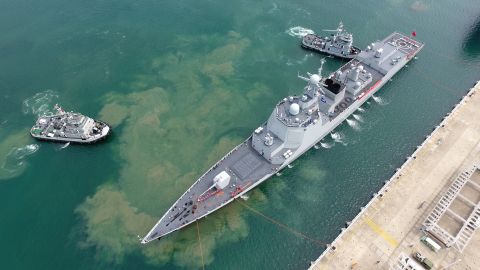China has the power to take Taiwan, but it would cost an extremely bloody price
Seoul, South Korea
CNN
—
On his first trip to Asia as United States President last week, Joe Biden gave his strongest warning yet to Beijing that Washington was committed to defending Taiwan militarily in the event of an attack from China.
Biden’s comments, which compared a potential Chinese attack on Taiwan to Russia’s invasion of Ukraine, appeared to deviate from Washington’s decades-old policy of “strategic ambiguity” on the issue and seemingly raised the possibility of a military clash between US and Chinese forces.
It’s the third time Biden has made similar remarks since taking office and, just as on the other two occasions, they were quickly walked back by the White House – which insists its policy has not changed. However, it inevitably raises the question: if China tries to take Taiwan, are the United States and its allies able to stop it?
And the alarming answer is: Quite possibly not. Analysts say China has more troops, more missiles and more ships than Taiwan or its possible supporters, like the US or Japan, could bring to a fight. That means that if China is absolutely determined to take the island it probably can.
But there’s a caveat; while China could likely prevail, any victory would come at an extremely bloody price for both Beijing and its adversaries.
Many analysts say an invasion of Taiwan would be more dangerous and complex than the Allied D-Day landings in France in World War II. US government documents put the number of killed, injured and missing from both sides during the almost three-month-long Normandy campaign at almost half a million troops.
And the civilian carnage could be far, far worse.
Taiwan’s population of 24 million people is packed into dense urban areas like the capital Taipei, with an average of 9,575 people per square kilometer. Compare that to Mariupol, Ukraine – devastated in the war with Russia – and with an average of 2,690 people per square kilometer.
Despite its numerical advantages in sea-, air- and land-based forces in the region, China has Achilles heels in each arena of war that would force Beijing to think long and hard about whether an invasion is worth the overwhelming human cost.
Here are some scenarios of how a Chinese invasion might play out:
China has the world’s largest navy, with around 360 combat vessels – bigger than the US’ fleet of just under 300 ships.
Beijing also has the world’s most-advanced merchant fleet, a large coast guard and, experts say, a maritime militia – fishing boats unofficially aligned with the military – giving it access to hundreds of additional vessels that could be used to transport the hundreds of thousands of troops that analysts say China would need for an amphibious invasion.
And those troops would need massive amounts of supplies.
“For Beijing to have reasonable prospects of victory, the PLA (People’s Liberation Army) would have to move thousands of tanks, artillery guns, armored personnel vehicles, and rocket launchers across with the troops. Mountains of equipment and lakes of fuel would have to cross with them,” Ian Easton, a senior director at the Project 2049 Institute, wrote in The Diplomat last year.
Getting a force of that size across the 110 miles (177 kilometers) of the Taiwan Strait would be a long, dangerous mission during which those vessels carrying the troops and equipment would be sitting ducks.
“The thought about China invading Taiwan, that’s a massacre for the Chinese navy,” said Phillips O’Brien, professor of strategic studies at the University of St. Andrews in Scotland.
That’s because Taiwan has been stocking up on cheap and effective land-based anti-ship missiles, similar to the Neptunes Ukraine used to sink the Russian cruiser Moskva in the Black Sea in April.
“Taiwan is mass-producing these things. And they’re small, it’s not like (China) can take them all out,” O’Brien said.
“What’s cheap is a surface-to-ship missile, what’s expensive is a ship.”

Still, China could – given its numerical advantage – simply decide the losses were worth it, pointed out Thomas Shugart, a former US Navy submarine captain and now an analyst at the Center for a New American Security.
“There’s gonna be hundreds if not thousands of (Chinese) vessels there to soak up those (Taiwanese) missiles,” Shugart said.
Missiles aside, China would face massive logistical hurdles in landing enough soldiers. Conventional military wisdom holds that an attacking force should outnumber defenders 3 to 1.
…
Read More: China has the power to take Taiwan, but it would cost an extremely bloody price

